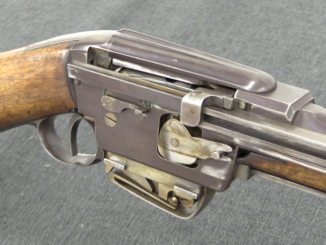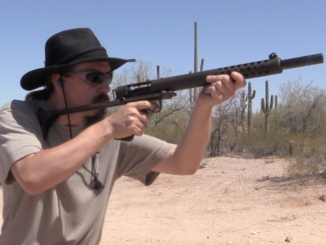Now that I have this high speed camera to use, I am going to be making high-speed video a regular weekly feature, at least until I run out of guns to film this way. Today’s is (by popular request) the Mauser C96 “Broomhandle”:
If I can get another chance to shoot a Schnellfeuer, you can bet that I’ll take the camera along for high speed footage of that variation!
In addition, I had a fellow point out an article I had missed on the Smith-Condit military rifle. It was originally published in the May 12, 1910 edition of Arms and the Man (the NRA’s magazine at the time), and reprinted in the 1911/1912 volume of the Journal of the US Cavalry Association. It is interesting for giving a positive opinion of gas-operated shoulder rifles, which were often disparaged at the time. It begins with some discussion of the new MExican rifle (the 1907 Mondragon), and then transitions to the Smith-Condit (made by Standard Arms). Also of note, it is clear through context that Standard Arms was already manufacturing their self-loading rifles for the civilian market when they got involved in the military trials program, as the author comments that readers familiar with the Standard Arms rifles will easily recognize the military model. You can download the article (5 pages) here:
A New Military Automatic Rifle (May 12, 1910 – English)
Thanks for pointing that out, Kit!




Your fancy new gadget is very handy for sure, I would like to see a Remington M51 and a R51 personally.
In the Smith-Condit the McLean is mentioned. The 37mm automatic gas operated gun designed by Samuel Neal McLean was used in Russia during WW1.
There: http://ww1.milua.org/R37Macleana.htm are description in Russian and images which explain the operation of the gun.
I’m wondering about which cartridge thought the inventor – Morris Smith – during designing his gun.
How many costs the Standard Arms Model G rifle compared to other rifles of early 20th century, not only the self-loading but also other like say Winchester Model 1894?
Fun video.
The C96 is a really neat pistol. I got a beat to bleep post war (WWI that is) Bolo for $400 a couple of years ago & spent $300 to restore it. Still couldn’t hit the side of a barn from inside 😀 so in the end I sold it for what I had in it. I’m glad to say I owned one & shot it but unlike some other firearms I’ve sold I do not miss it. I do miss the near mint S&W Model 10 I sold to finance it but that’s a mistake for another day… 😉
The google pdf does not seem to be working for me.
It’s Chrome’s PDF rendering engine. Downloading it, it opens fine in Foxit or SumatraPDF.
I don’t care if the C96 is obsolete. It would still be my pistol of choice when the Zombie Hordes swarm the city 😉 . Neat gun. I had a chance to buy one back in the ’70’s, but I was a lowly second lieutenant and it was beyond my budget. Thanks for the video.
This video is nearly a full education for a firearm student. Please notice how the “Back Stop” retains its place on the recoling pistol through inertia. This piece is the part holding the recoil spring and firing pin inside the barrel extention and also is the key part of pistol’s take down. This event is also the answer why the recoil springs are not effective for delaying the breech opening at instant of firing. Thanks Ian.
nice clip!
It would be nice (i think) if there is a full speed segment of the slowed down footage (or the same action)in the same video, make the highspeed footage even more awesome!
There is a video of this cute pistol on YT which supplements Ian’s findings. Yes indeed, the muzzle rise is there, so is with other handguns…. big deal. Have to live with it.
After more than century one’s mind poses in amazement, strokes of genius are clearly visible.
Lots and lots of bouncing going on.
The slide looks like its putting in a couple of back and forth bounces as the bolt is travelling back (does the bolt have bright patches on its underside where the locking block catches it during those bounces?
Also in the top view, there is quite a bounce as the bolt goes into battery (possibly unhealthy for a schnellfeur – it’s a good job that the hammer travel is slow)